4.2.2.3 - What sprinklers do I need?
Return to Main Menu | Return to Step 4 | Return to Step 4.2.2 | Next Step
Note the regulators above the sprinklers, and the lead weight to restrict sprinklers on flexible drops from moving in the wind.
LEPA (low energy precision application) emitters (such as "bubblers" and "LEPA socks") are not suitable for pasture or lucerne. They are suited to crops such as maize when grown on rows in a circle.
Each sprinkler type is provided with interchangeable nozzles of varying size, to accommodate the design flow rate. This rate increases along the length of the pivot (but not on a lateral move – see Step 4.2.2.8).
The nozzle size (and hence flow rate) is sometimes reduced to limit the amount of water hitting the towers and falling on the wheel tracks. This may have some success in slowing the development of wheel ruts, particularly when used in half throw sprinklers directed away from the towers (see below and Step 4.2.2.5). However, this impacts on the irrigation uniformity.
Note: Low pressure sprinklers are more sensitive to changes in elevation, and are more likely to require pressure regulators. System designers should determine the need for pressure regulators on a system according to the sprinkler pressure required, the elevation variation on the site and the presence of an intermittently operating end-gun.
The AAR increases along the length of the pivot as the nozzle flow rate increases, and varies with system capacity. High AARs are more likely to be an issue on longer pivots with higher system capacities.
Designers generally aim to keep the AAR below 80 mm/h; 100 mm/h at most. That is, while a typical irrigation application may be say 25 mm, the rate of application can be as high as 100 mm/h, at the outer end of a pivot. This greatly exceeds the final infiltration rate of most soils which in the SIR is typically 1 to 3 mm/h . Most of the say 25 mm applied is taken up in the rapid initial wetting up or crack fill phase of infiltration, leaving perhaps 5 to 10 mm to infiltrate at the final infiltration rate. For more information on infiltration rates, see “soil types” in Step 4.1.3.
Where the average application rate is excessive and/or the irrigation application is higher than say the 25 mm example above, ponding and runoff can occur.
The average application rate can be kept to a minimum by:
Run-off is less likely to be a concern on perennial pastures than under crops and perhaps lucerne. Pastures provide good soil cover and protect the soil from the impact of droplets. Pastures also allow a small depth of water to pond before run-off occurs.
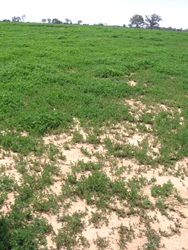
Excessive application rates on sloping ground can allow insufficient infiltration, runoff and poor crop growth
Page top
There are several types of sprinkler (also called emitters) that can be used on pastures (and lucerne and maize):
Fixed plate sprinklers are the simplest and cheapest. They have a relatively small throw and are suitable for pastures, provided that the sprinkler spacing along the span-pipe is close enough and the AAR is not excessive – see below.
Moving plate sprinklers (spinners, rotators and wobblers) have greater throws, produce a more uniform droplet size and a better distribution uniformity. “Wobblers” perhaps have the best performance, at relatively low pressure.
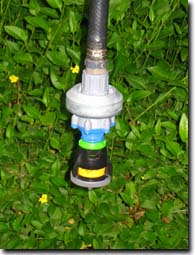 Moving Plate Sprinkler | 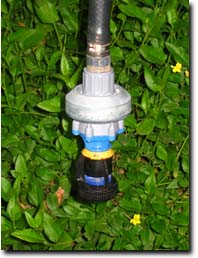 Fixed Plate Sprinkler | 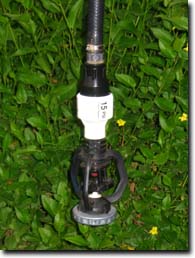 Wobbler Sprinkler |
Note the regulators above the sprinklers, and the lead weight to restrict sprinklers on flexible drops from moving in the wind.
LEPA (low energy precision application) emitters (such as "bubblers" and "LEPA socks") are not suitable for pasture or lucerne. They are suited to crops such as maize when grown on rows in a circle.
Each sprinkler type is provided with interchangeable nozzles of varying size, to accommodate the design flow rate. This rate increases along the length of the pivot (but not on a lateral move – see Step 4.2.2.8).
The nozzle size (and hence flow rate) is sometimes reduced to limit the amount of water hitting the towers and falling on the wheel tracks. This may have some success in slowing the development of wheel ruts, particularly when used in half throw sprinklers directed away from the towers (see below and Step 4.2.2.5). However, this impacts on the irrigation uniformity.
| Half-throw sprinklers are available for some sprinkler types. These wet approximately half a circle, and can be beneficial in keeping water off the towers and wheel tracks, particularly when mounted on “boombacks”. See DPI Agnote “Centre Pivot Wheel Rutting”(PDF 1.3MB). To view the information PDF requires the use of a PDF reader. This can be installed for free from the Adobe website (external link). Pressure regulators installed immediately above each sprinkler limit the pressure at the sprinkler to a specified level, typically 7 to 15 m (10 to 20 psi). This avoids sprinkler pressure variation resulting from elevation difference in various parts of the irrigated area or the intermittent operation of an end-gun, that would vary the flow rate of the sprinklers, which would in turn affect the uniformity of the irrigation. Most modern systems utilise pressure regulators. However, pressure regulators themselves require a pressure drop (head loss) of some 3.5 m (5 psi) to operate, which increases the system’s pumping cost. Operating without pressure regulators may be possible if the irrigated land is relatively flat. However, if an end gun is installed that is intermittently turned on and off at different parts of the circle, this varies the pressure in the span pipe, making pressure regulators necessary even on flat land. | 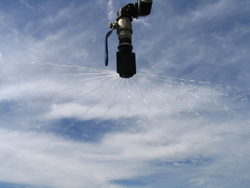 Half-throw sprinkler pattern |
End-guns are generally not recommended because:
E.g. The nozzle flow rate at the outer end of a pivot is 2700 L/h. The sprinklers are spaced at 3 m, and have a throw diameter of 12 m. | 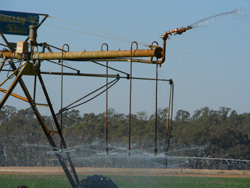 End-gun with booster pump |
The AAR increases along the length of the pivot as the nozzle flow rate increases, and varies with system capacity. High AARs are more likely to be an issue on longer pivots with higher system capacities.
Designers generally aim to keep the AAR below 80 mm/h; 100 mm/h at most. That is, while a typical irrigation application may be say 25 mm, the rate of application can be as high as 100 mm/h, at the outer end of a pivot. This greatly exceeds the final infiltration rate of most soils which in the SIR is typically 1 to 3 mm/h . Most of the say 25 mm applied is taken up in the rapid initial wetting up or crack fill phase of infiltration, leaving perhaps 5 to 10 mm to infiltrate at the final infiltration rate. For more information on infiltration rates, see “soil types” in Step 4.1.3.
Where the average application rate is excessive and/or the irrigation application is higher than say the 25 mm example above, ponding and runoff can occur.
The average application rate can be kept to a minimum by:
- choosing sprinklers with large throw diameters; and
- if the AAR is still too high, sprinklers can be mounted on either side of the span pipe on spreader bars fixed to the truss rods, to spread the wetted area.
Run-off is less likely to be a concern on perennial pastures than under crops and perhaps lucerne. Pastures provide good soil cover and protect the soil from the impact of droplets. Pastures also allow a small depth of water to pond before run-off occurs.

Excessive application rates on sloping ground can allow insufficient infiltration, runoff and poor crop growth


